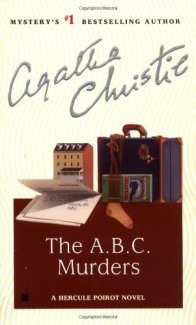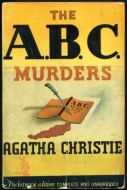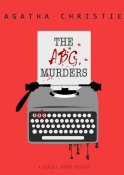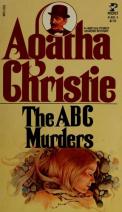After a deep study of The A.B.C. Murders, I see just how bad-ass Agatha Christie was. She truly earned the title “The Queen of Crime.” One way she earned her crown: her use of clues.
Part of any mystery’s fun is the deduction of a clue’s status: red herring, or genuine? Mysteries must be addled with both in order to satisfy both the narrative and the reader. That woman managed to make a ton of clues both red herrings and genuine clues, and it’s never clearer than in The A.B.C. Murders. It’s so clear, in fact, that some publisher thought it was smart to throw the most important elements of the mystery onto a book cover.

Gah, this one really pisses me off!
No, I’m not over-reacting.
Look, I get that all book covers need to attract readers, and what better way to draw readers to a mystery than by putting a mystery on the cover, right? If you pop on back to my earlier post on this story, you’ll see two covers that focus on different elements:
 You got your railway guide. Important, but not a giveaway.
You got your railway guide. Important, but not a giveaway.
 You got the killer’s shadow and A.B.C. Neither are giveaways.
You got the killer’s shadow and A.B.C. Neither are giveaways.
 Typewriter: Ibid.
Typewriter: Ibid.
 Corpse: Ditto Ibid. Etc. Etc. Etc.
Corpse: Ditto Ibid. Etc. Etc. Etc.
That one cover with the stockings and letter, though…THAT one is showing off a little too much. (Shout-out to Sarah Higbee for getting me into these book cover comparisons!)
Let’s start with the letters. The first arrives on page 4:
MR. HERCULE POIROT–You fancy yourself, don’t you, at solving mysteries that are too difficult for our poor thick-headed British police? Let us see, Mr. Clever Poirot, just how clever you can be. Perhaps you’ll find this nut too hard to crack. Look out for Andover on the 21st of the month. Yours, etc., A.B.C.
The other three letters have this same tone: confident and mocking, with oodles of superiority. Inspector Crome of Scotland Yard, Hastings, and others dismissed the initial letter, but after the first murder each letter is treated as a window into the mind of the killer. Three of the four letters arrive some days in advance, even, as a way to let Poirot and the Yard prevent the next crime, but Poirot and the Yard’s measures are never enough. Only one letter arrives late because of an incorrect address, which the Yard puts off as an accident:
Poirot gave [the letter] to [Inspector Crome].
He examined it, swearing softly under his breath.
“Of all the damned luck. The stars in their courses fight for the fellow.”
“You don’t think,” [Hastings] suggested, “that it was done on purpose?”
Crome shook his head.
“No. He’s got his rules–crazy rules–and abides by them. Fair warning. He makes a point of that. That’s where his boastfulness comes in. I wonder now–I’d almost bet the chap drinks White Horse whisky.”
“Ah, c’est ingenieux ca!” said Poirot, driven to admiration in spite of himself. “He prints the letter and the bottle is in front of him.”
The letters offer no forensic help, and only when the families of the first three victims come together does there seem to be any hope in catching the killer. In Chapter 21, Poirot deeply believes that conversation among the family members and witnesses will reveal the killer:
“Each one of us knows something about him–if we only knew what it is we know. I am convinced that the knowledge is there if we could only get at it.”
And sure enough, by the end of that chapter, a major connection is made when the third victim’s secretary recalls a stockings salesman coming to their door. The sister of the second victim mentions that her mother bought stockings for the victims the day she died. A reader can flip back and confirm what police say: a new pair of stockings was included in the first victim’s belongings.
Poirot presses the police to use the stockings angle, but they dismiss it as a coincidence. Of course they do! It’s only A MAJOR CLUE, right? And it does help: after the fourth victim is discovered, a man is spotted, bloody and bewildered, fleeing his room. A suitcase of new stockings was left behind. The man: Alexander Bonaparte Cust. A quiet man. Awkward. Shabby. Shy. Epileptic, and not medicated, so his memory has big gaps. He’s been to every location the day of a murder. He has a bloody knife, for crying out loud. The pressure to find him reaches such a fever that Cust himself walks into a police station in a daze and collapses.
So endeth the A.B.C. murders, yes? A typewriter in his room was the same used to write the letters. More stockings. More railway guides. All the clues are there….
And yet.
At the end of Chapter 31, Hastings wakes up from a nap to discover Poirot’s figured it out, and he’s going to be damned gleefully secretive about it. He’ll only say what he’s said before:
“There is nothing so dangerous for any one who has something to hide as conversation.”
Poirot meets face to face with Cust. Cust doesn’t recognize the detective’s name at all. He has no memory of the murders. Another man even remembers playing dominoes with Cust in a different part of the town where the second murder happened. And the second murder victim, a pretty young girl who liked to party, would NOT have given a guy like Cust the time of day, let alone her belt to be strangled with.
Yet the clues point to Cust. Cust even thinks he did the murders–he can’t remember those days, and as a stranger told him while reading his palm, he’s destined for the gallows…
Cust’s conversation reveals how some old clues are impacted by new clues. His character, for one, is in total contradiction with the letters. Unless the guy’s got split personality disorder, there’s no way a wuss like him is the snot who wrote the letters. He also talks about his dead-end job after the war, and the blessing that came with this selling job: a door-to-door job with a salary and commission. To any one with an iota of common sense, the idea of selling stockings door to door for a big salary and commission should sound questionable.
See what Christie did here? Those major clues–the letters, the stockings–were red herrings to take Poirot and the Yard to Cust. But those clues also reveal genuine hints of the true killer. By building us to this false climax of the killer caught, Christie increases tension a hundred fold. Despite Hastings’ skepticism (you’d think he’d know better by now), readers can’t help but read on to find out what Poirot’s discovered. I mean, I was super-peeved because my school contacted me about teaching and my son had the audacity to get sick. The wait until evening for those last fifteen pages was agony!
Chapter 34 is entitled “Poirot Explains,” for this is when all is explained to the families of the victims. Yes, it’s the typical gathering of suspects–it wouldn’t be a Poirot mystery without it. 🙂 Poirot focuses on the letters first: why write to Poirot, and not the Yard? Why commit these murders at all? Everyone else had thrown their hands up at “madness!” because that was the catchword of the day, apparently, and therefore everything’s justified. But Poirot points out that if a madman just wants to kill, why in Hades would he draw attention to himself, and therefore risk getting caught? He goes on with these contradictions found with the other clues, like the railway guide. There’s no discernable motive to be tied to Cust, or justification from any off-balance point of view.
So Poirot turns it all on its head with this base deduction about the letters:
“What was wrong with them was the fact they were written by a sane man!”
After all the “What?!?” by the victims’ families, Poirot points out how easy it is to hide something:
“When do you notice a pin least? When it is in a pin-cushion! When do you notice an individual murder least? When it is one of a series of murders.”
Now the letters become a major, genuine clue: the third letter, the only one mislabeled–the one Hastings wondered had been mislabeled on purpose–was for the murder that needed to happen without interference. When approached with that in mind, suddenly the true killer comes to the forefront: the boyish, adventurous, and broke brother of the third victim. He is one who could get that pretty girl to give him her belt. He is one with the snot-attitude that fits the letters to a T. He is one with the risk-taking spirit to kill in the open one night and approach the police the next. He had met Cust, and put the idea of the gallows destiny in his head. He planned out everything, from the bulk purchase of stockings and railway guides, to sending Cust the typewriter he used to type all the A.B.C. letters beforehand. He selected Poirot to get the letters because a letter addressed to Scotland Yard won’t go astray, but a letter to a private address can!
So yes, I’m still miffed about that one book cover. It took two of the most important pieces of the mystery and stuck them on the cover, forcing them to always be at the forefront of the reader’s mind. I’m also miffed this book isn’t used in more writing classes. It’s a brilliant piece of a mind-game: the clues alter in importance depending on the latest piece of information. What was once deemed important becomes a red herring only to become important again. And the fact that Christie gives us little chapters from Cust’s point of view early on makes us think we’re keeping tabs on the killer, and yet we can tell from those snippets what a shy, shabby fellow he is, devoid of confidence or wit. She’s giving us both a red herring and a real clue with every scene.
All method. No madness.
All hail the Queen of Crime!
